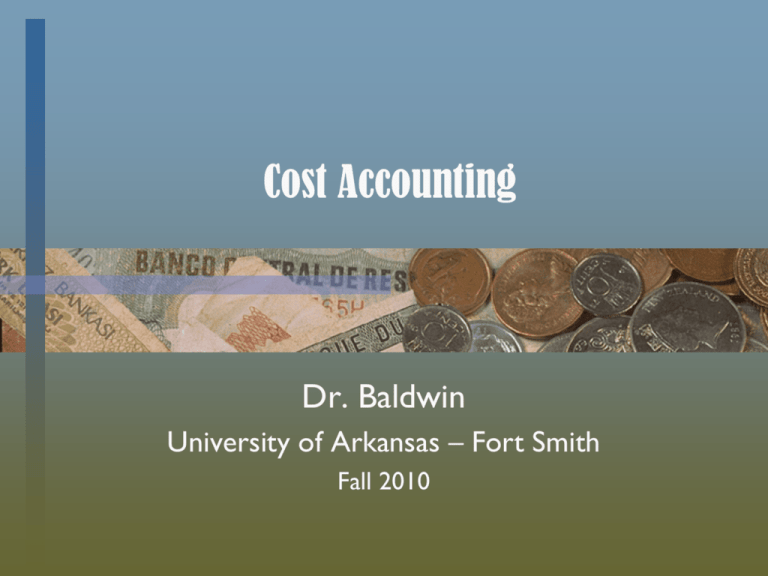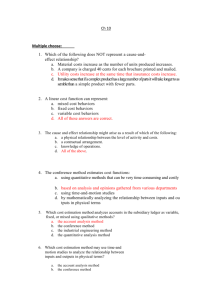Variable Costs
advertisement

Cost Accounting Dr. Baldwin University of Arkansas – Fort Smith Fall 2010 Chapter 10 Determining How Costs Behave 2 Why understand cost behavior? • Managers need to understand cost behavior in order to make decisions about strategy and about operations. • For example – Product decisions • Apple iPod, iPhone, iPad • Amazon Kindle – Other decisions • Fort Smith administration enrollment 3 What do we already know about the nature of costs? Variable Cost Cost Mixed Cost Fixed Cost Volume of Activity 4 Assumptions • Costs are linear – or approximated by linear functions • Each cost has a single cost driver • Are these always true? Not always! • We generally assume they are true within the relevant range. • Exercise 18. 5 Relevant Range • The range of the activity in which total cost and the level of activity are related. 6 How to understand cost behavior? A cost function is • a mathematical description of how a cost changes with changes in the volume of its cost driver activity. Variable Cost Cost Mixed Cost Fixed Cost Volume of Activity 7 Linear Cost Functions example • Let’s assume you are a spin class instructor and you have to provide your own music for class. You spend a lot of time and money downloading songs to use in class. uTunes is providing three different payment options. – Let’s look at the options and identify the cost function for each. 8 Linear Cost Functions example • Option A – Pay $5 per song downloaded • Option B – Pay $100 per month for unlimited downloads • Option C – Pay $50 per month plus $0.50 per download • Create a cost function for each option using the generic linear cost function formula. 9 Create a Linear Cost Function Formula: Y = a + bX • Where: – – – – Y = total costs a = fixed costs b = variable cost per unit of cost driver X = cost driver • Option A: • Option B: • Option C: Y = $0 + $5X Y = $100 + $0X Y = $50 + $0.50X 10 How to understand cost behavior? • Option A: • Option B: • Option C: Y = $0 + $5X Y = $100 + $0X Y = $50 + $0.50X Variable Cost A Cost Mixed Cost Fixed Cost B Volume of Activity (downloads) 11 C Calculate Total Cost of Each Option Which option is least expensive? • Assuming 40 downloads a month, what is the total cost per month for each option? • Option A: • Option B: • Option C: Y = $0 + $5 * 40 = $200 Y = $100 + $0*40 = $100 Y = $50 + $0.50*40 = $70 • What happens if you download more or less than 40? 100? 200? 12 How to understand cost behavior? • Option A: • Option B: • Option C: Y = $0 + $5X Y = $100 + $0X Y = $50 + $0.50X Variable Cost A Cost Mixed Cost Fixed Cost B 20 100 10 Volume of Activity (downloads) 13 C How to understand cost behavior? Cost Estimation Methods • Many methods to estimate costs • Potential problems in cost estimation – Availability of historical data – Accuracy of data – The estimates are only as good as the data on which they are based. 14 How to understand cost behavior? Cost Estimation Methods • Industrial Engineering – Time and motion studies • Conference – Consensus of estimates • Account Analysis • Quantitative Analysis – High-Low Method – Regression 15 Account Analysis Method Use knowledge of operations to • Classify cost accounts according to their relationship with the cost driver activity: – variable, fixed, or mixed • Estimate the cost/driver relationship • Example: Lorenzo’s Car Wash (Exercise 20) 16 Lorenzo’s Car Wash example • Incoming cars are put on a conveyor belt. • Cars are washed as they are carried by the conveyor belt from start to finish. • The cars are then dried manually. • Workers clean and vacuum car inside. • They are managed by a single supervisor. • Lorenzo serviced 80,000 cars in 2009, for which he reports the following costs: 17 Lorenzo’s Car Wash example Accounts Car Wash Labor Soap and Supplies Water Power Salaries Depreciation Total Costs $260,000 $42,000 $38,000 $72,000 $46,000 $64,000 Use knowledge of operations to • Classify cost accounts according to their relationship with the cost driver activity: – variable, fixed, or mixed 18 • Estimate the costs if 90,000 cars are washed in 2010. Lorenzo’s Car Wash example • Classify: variable, fixed, or mixed Accounts Car Wash Labor Soap and Supplies Water Power Salaries Depreciation Total Costs $260,000 $42,000 $38,000 $72,000 $46,000 $64,000 Variable $412,000 Fixed $110,000 19 Lorenzo’s Car Wash example • Variable Costs for 2009 $ 412,000 80,000 cars = $5.15 per car • Fixed Costs $110,000 • Total average cost per car = (412,000 + 110,000) 80,000 cars = $6.53 per car 20 Lorenzo’s Car Wash example Estimate Lorenzo’s 2010 costs (90,000 washes) • Variable Costs 90,000 cars * $5.15 per car = $463,500 • Fixed Costs $110,000 • Total costs = $463,500 + $110,000 = $573,500 21 How to understand cost behavior? Cost Estimation Methods • Industrial Engineering – Time and motion studies • Conference – Consensus of estimates • Account Analysis • Quantitative Analysis – High-Low Method – Regression 22 Quantitative Analysis • Uses formal mathematical methods to fit cost functions to past data observations. • Remember, a cost function is a mathematical description of how a cost changes with changes in the level of its cost driver activity. – Total costs = FC + VCUNIT * activity – Lorenzo’s cost function: • $110,000 + $5.15 per car * number of cars 23 Estimate a Linear Cost Function • Formula: Y = a + bX • Where: – – – – Y = total costs a = fixed costs b = variable cost per unit of cost driver X = cost driver • Two methods – High-Low Method – Regression Analysis 24 High-Low Method • Uses two points (the high and the low) to find the equation of the cost line y = a + bx – slope = b = change in y/change in x – intercept = a = y - bx • Strengths – Simple to compute – Easy to understand • Weaknesses – Only two points used - what if they are not representative of normal relationship? • Exercise 16. 25 Regression Analysis • Uses all the observations to find the equation of the cost line y = a + bx – slope = change in y/change in x – intercept = a = y - bx • Regression minimizes the sum of the squared differences between the observed data and the predicted line • Strengths – More accurate than the high-low method 26 Statistical Output Provides • estimates of the two parameters in the cost function: Y = a + bX – a = intercept = fixed costs – b = slope = variable costs per unit • Measures of goodness of fit – Co-efficient of determination = r2 • Measures the % variation in Y explained by X Larger is better – T-statistic = b/standard error of estimated co-efficient • t tells us if b is different from zero 27 Statistical Output What do we do with it? • Check goodness of fit measures – Want r2 .3 (or perhaps even higher) – Want t 2 • Compare cost drivers to see which is best • Estimate Y (total costs) for future period. 28 Non-Linear Functions Costs are not always linear! For example: • Quantity discounts – Costs decrease as volume increases • Step cost functions – Costs increase by discrete amounts over narrow ranges • Step fixed-cost functions – Cost remain the same over wider intervals • Learning curves 29 Learning Curves A learning curve is a function that measures how laborhours per unit decline as unites of production increase because workers are learning and becoming better at their jobs. Two types: • Cumulative average-time learning model – Average time per unit declines at a constant rate • Incremental unit-time learning model – Time to produce last unit decreases at a constant rate Learning curves are given as a percentage 30 Learning Curves • Formula: Y = pXq • Where: – Y = cumulative average time or incremental time – p = labor hours on first unit – X = cumulative # of units – q reflects the learning rate (log of learning curve) 31 Learning Curves • Learning is faster in which model? – (cumulative model) • Which of these models will predict higher costs? – (incremental model) • Which of these models is better? – It depends! Case by case basis decision. 32 Learning Curves • What are implications for product costing? – Charge more initially and decrease price as time to produce declines? • Will the customers put up with that? – Price down the learning curve - set price based on what we expect costs to be in the future • Why might companies do this? 33 Summary 1 • Managers have to understand cost behavior in order to make decisions about strategy and about operations. • Most of the time we assume costs are linear and each has single cost driver. • A cost function is a mathematical description of how a cost changes with changes in the level of its cost driver activity. – Formula: Y = a + bX • Costs are not always linear (e.g. learning curves). 34 Summary 2 Cost Estimation Methods help us understand cost behavior. • Industrial Engineering (Time & motion studies) • Conference (consenses) • Account Analysis • Quantitative Analysis – High-Low Method – Regression 35 Summary 3 • Many methods to estimate costs • Potential problems in cost estimation – Availability of historical data – Accuracy of data – The estimates are only as good as the data on which they are based. • Don’t forget to read the appendix which discusses regression. 36

